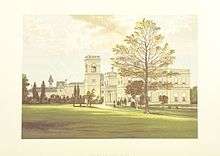John Henry Hakewill


John Henry Hakewill (1810–1880)[1] was an English architect who designed Stowlangtoft Hall in Suffolk and restored many churches in East Anglia, Wiltshire and Nottinghamshire.
Family
Hakewill was the son of Henry Hakewill and Anne Sarah Frith. His brother Edward Charles Hakewill (1816-1872) was also an architect.
Career
J. H. Hakewill was article to his father and a pupil of John Goldicutt.[2]
Hakewill began to practise in 1838. His first major work was the church of St John of Jerusalem, South Hackney (1845–48).[2] He was the architect of a hospital at Bury St Edmunds, Stowlangtoft Hall Suffolk, and churches in Yarmouth,[3] Wiltshire and Nottinghamshire.[4]
Hakewill published a study, The Temple: an Essay on the Ark, the Tabernacle, and the Temple of Jerusalem, in 1851. He retired to Playford, Suffolk in 1867 but continued to design churches there, at Stonham Aspal and Grundisburgh. He was also responsible for Wickham Manor.[2]
References
- ↑ John Henry Hakewill (1810–1880). Oxford Dictionary of National Biography. Oxford University Press. Retrieved 31 July 2015.
- 1 2 3 "Goldicutt, John", Bertha Porter, rev. M.A. Goodall, Oxford Dictionary of National Biography, Oxford University Press, 2004. Retrieved 12 July 2015. (subscription required)
- ↑ Lot 45. Bonhams. Retrieved 31 July 2015.
- ↑ E. g. Neston, near Corsham, the Church of St John of Beverley, Scarrington and St John the Baptist's Church, Collingham.
Further reading
- Obituary in Building News, Vol. 39, 10 September 1880, p. 311.
External links
![]() Media related to John Henry Hakewill at Wikimedia Commons
Media related to John Henry Hakewill at Wikimedia Commons